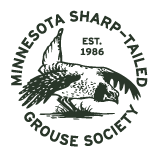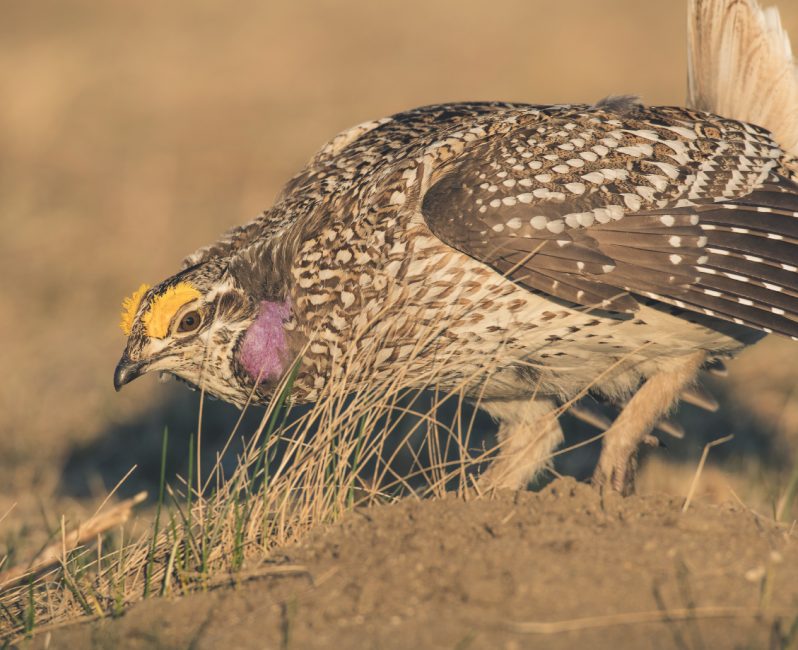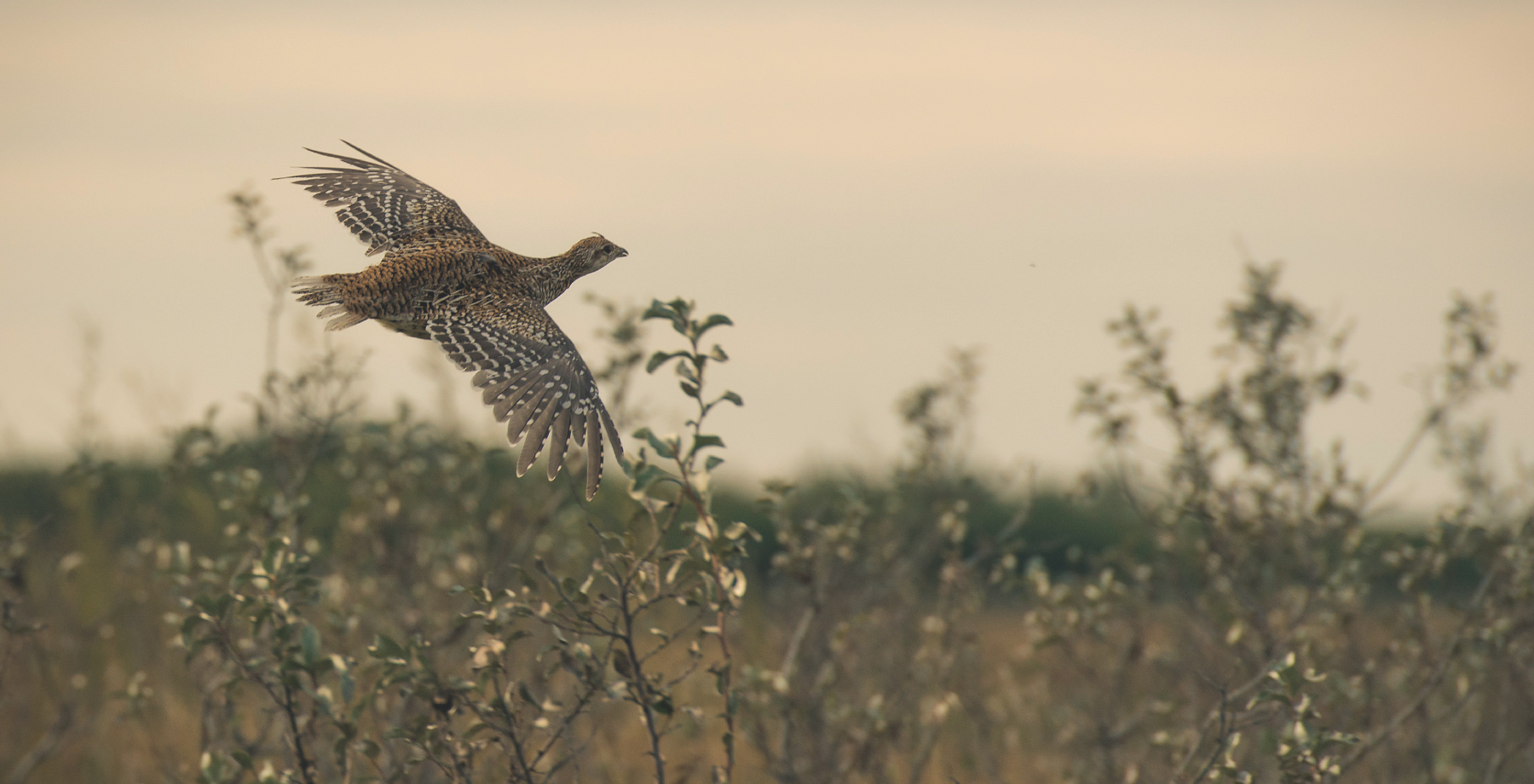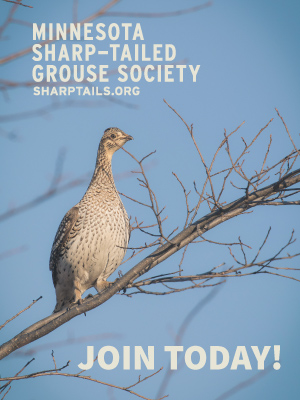USDA Fish and Wildlife Habitat Management Guide Sheet – Natural Resources Conservation Service (NRCS) – Minnesota
Learning about the Iconic Prairie Grouse
The sharp-tailed grouse is perhaps the only prairie grouse indigenous to Minnesota, preferring the transitional type habitat comprised of open grass-brushland, savanna, and open boreal peatlands. Sharptailed grouse were once one of Minnesota’s most abundant game birds. Hunters annually harvested over 100,000 of these game birds in the 1940’s, but loss of habitat has reduced the harvest to less than 10,000 in recent years. Because its open brushland habitat is vulnerable to destruction, natural succession and conversion to unacceptable cover (cropland, conifer plantations), their numbers have declined dramatically. The current sharptail range is restricted to northern Minnesota’s mixed forest and aspen parkland regions. The primary range is focused in the grass/brushland and boreal peatland of the Agassiz and Tamarack lowlands ecoregions (fig. 1). The northwest range holds about two-thirds of the state’s sharptails. The open grass-brushland habitats that sharptails need are also homes to dozens of other rare and interesting birds with declining populations, such as the bobolink, savanna sparrow, sandhill crane, short-eared owl, and yellow rail.
Annual Life Cycle
Courtship Period
The courtship activity of the sharptail is an impressive performance. It is done on an area referred to as a “lek” or “dancing ground” consisting of bare, grassy or sparse shrub land; it often occurs on a hill or rise in the ground. Young sharptail cocks begin to visit a dancing grounds with the adults in early fall; however the serious courtship activity begins as spring arrives, usually in late March. The same leks may be used year after year if not destroyed by cultivation, the invasion of dense woody vegetation or tree planting. The number of birds using leks varies depending on the population, but averages about 8-12.
The birds arrive about 45 minutes before sunrise, each selecting a position on the lek. The morning activity usually lasts 3-4 hours. Neck sacks are inflated and the neck is stretched forward as a hooting or cooing sound is made. The wings are spread horizontally with tips curved downward.
The neck feathers are raised and the eyebrow expands nearly to the top of the crown. The tail is held in an erect fan, and is vibrated sideways. From this stance the cock rushes forward or goes into a circular motion with short, rapid, stamping steps, meanwhile vibrating the tail continuously. Much of the activity in early spring consists of sparring and bluffing to resolve territory disputes. Hens congregate around the edge of the lek acting nonchalant. But eventually each one walks among the performing birds, selects a male, and mating occurs. The spring courtship activity period usually wanes by mid-May.
Nesting Period
In late April or May, hens seek out a nesting place usually within a half mile of a dancing ground. The nest is a hollow in the ground, lined with grass, leaves, and feathers. Nests are typically located in grass or next to brush clump, a stump or other protective cover. The typical clutch size is 12 eggs and the incubation period is 23 days. Some nests are known to have as few as 5 eggs, or as many as 17. Hens will typically bring off one brood, however studies indicate that hens losing their nests early in incubation will nest again.
The hen’s behavior during incubation is typical of most grouse. She leaves the nest for feeding in early morning, and again in the evening. During much of this time males are continuing their dancing ground activities, but for less duration. The males finally disperse by late May or early June. Hatching of first nests varies somewhat, with Minnesota birds usually hatching in late May and early June. Hatching may vary as much as 7-10 days later in cold, wet years with renests hatching as late as July.
Brood Period
The hatching period is a dangerous time for sharptails as well as other ground-nesting birds. Predation and weather are the greatest threats to young chicks. The brood is led away from the nest soon after hatching is complete. Only the hen provides parental care, as males and broodless females spend the summer singly or in small groups. Summer cover is similar as that used for nesting; except that broods prefer burned or lightly grazed habitats with abundant insects and openings for movement.
Chicks grow rapidly, and are able to fly somewhat when they are 10 days old. Their early food is mostly insects, and they spend much of their time foraging for food when not being brooded. When the chicks reach 8 to 10 weeks, they resemble small adults and begin to show signs of independence. They dust themselves, loaf in shade, and feed on summer fruits and greens. By mid-September to October they look like adults.
Fall and Winter Period
Sharptails always roost on the ground. As fall approaches, the family unit breaks up and flocking begins. The flock size increases as winter approaches and is largest in late fall and early winter. Five to ten birds in a group is normal for midwinter. There is some activity on dancing grounds in the fall, probably by males establishing territories, but not to the intensity of the spring breeding season. In autumn, birds associated with agricultural lands utilize cropfields, foraging on small grains and associated weed seeds. They also forage in brushland for fruits and other green vegetation. As winter sets in, food is harder to find and birds may travel several miles to find adequate food and roosting sites. They turn to buds of aspen, willow and bog birch for much of their food, and to lowland and brush thickets for roost sites. Roosting in deep snow is also common, much in the same manner as the ruffed grouse.
Habitat Requirements
The key to sharp-tailed grouse habitat is a complex of grassland mixed with a mosaic of brush and open woodland. These are typically large grass or herbaceous cover areas resulting from fire, logging, abandoned farms, and sometimes abandoned iron mine tailings basins. Habitat typically consists of natural meadows, pastures, open bogs, abandoned farm clearings, small grain cropland and inactive commercial rice paddies. The brushland surrounding the lek (1/4 –1/2 mile radius), satisfies most of the birds basic needs for shelter, nesting cover, and food. However, once woody vegetation becomes established and matures, the habitat will be of little value to sharptails unless natural succession is set back to the grassland/brushland stage. The larger the open area, the better, as sharptails need an open vista to warn them of approaching predators. Conifer plantings or hybrid poplar plantations fragment these open vistas, and are not compatible with sharptail management.
Food
Sharptails feed before sunrise and at sunset, and often travel 1-3 miles a day. If natural habitat is adequate, a diet of insects, green leaves, flowers, fruits, weed seeds, and browse from brush and trees will support good populations throughout the year. Vegetative materials comprise 90% of annual food supplies, while insects comprise 10%. During the winter, food is most critical and the sharptail must depend on grain, dried fruits, buds and catkins, and in some circumstances, food plots.
Cover
Critical for sharptail habitat is the lek and its associated vegetative cover. The entire habitat complex will be abandoned if the brushland composition or lek become unsuitable. The lek setting is critical, for it minimally requires a 1/8 mi. diameter area relatively free of woody vegetation. Terrain of the lek is usually flat to slightly convex, and consists of grass, sedge, tame hay, crop stubble, open pasture, or tilled cropland. Average distances (yards) from the lek center to woody vegetation of various heights (feet) are: scattered brush (195 yds./16 ft), dense brush (230 yds/7 ft), brush-tree mix (275 yds/16 ft), and trees (305 yds/23 ft).
Optimum brushland cover consists of fruiting shrubs 3-7 feet high. The brushland complex will support fewer birds as vegetation becomes over mature and changes to forest. Except for an occasional small black spruce or tamarack, sharptails are sensitive to planted or naturally occurring conifers. Sharptails are totally intolerant of any conifers within ¼ mile of the lek, and relatively intolerant of conifers within ½ mile. Once conifers approximately ¼ mile from the lek center exceed 20 feet, or if conifers ½ mile distant exceed 40 feet, the habitat will become unsuitable. Thus, tree plantings, even as windbreaks and shelterbelts, should be avoided in sharptail habitat complexes.
Habitat Size and Composition
The minimum size of sharptail habitat, which may include multiple landowners, depends on its configuration. Where suitable habitat is remotely scattered throughout its range, the habitat size must be a minimum of 2 square miles, and preferably 4 square miles. Where habitat exists rather uniformly in scattered but connected blocks, open habitat must be at least ½ square mile. The optimum habitat composition is 35% grass-legume cover, 15% small grain cropland, 7% sedge marshland, 16% willow, and 9% lowland brush and scattered trees.
Management Recommendations
Management treatment should address the habitat components that are determined to be limiting sharp-tail habitat potential. For evaluation purposes, select among the possible actions listed below to improve habitat quality or availability of each habitat component determined to be limiting.
Food
- Encourage use of cropland conservation tillage systems which leave waste grain on the soil surface over winter.
- Retain standing row crops and small grain over winter adjacent to, or within ¼ mile of winter cover.
- If needed, establish annual food plots of buckwheat, oats, or flax at least 1.0 acre in size adjacent to winter cover and/or dancing grounds. Corn, sorghum or sunflowers should be avoided near dancing grounds. Locate food plots at least 100 yards away from trees over 15-20 feet tall to minimize predation by raptors.
- Where food plots are not feasible, baled small grain may be transported to the site.
- Manage fruit-bearing shrubs, and aspen or paper birch on the periphery for winter food (buds).
Cover
- Retain existing marshes, muskegs, grassland and brush areas.
- Don’t plant conifers within ½ mile of dancing grounds.
- Remove tall trees near food plots and leks.
- Manage brush adjacent to leks prior to May 15 through periodic prescribed burning, mowing or shearing (dozing) every 5-10 years once brush exceeds 7-8 feet.
- In the absence of existing leks, new ones can be created by mowing a 100200 foot oval area in the fall. Two to three sites per 160 acres is adequate.
- Light to moderate grazing on a rotational basis will help control natural succession.
- Delay mowing of roadsides and hayfields until after August 1.
Habitat Composition
- Use a greater variety of agricultural crops and rotations. Crop diversity is more likely to provide for basic needs.
- Degraded habitat complexes can be restored by establishing new cover, or managing existing cover through a combination of prescribed burning, shearing, and logging.
Size
- The minimum size of habitat blocks should be ½ square mile and preferably, 2.0 square miles. The larger the open area, the better for both sharptails and other bird species dependent on open lands.
References:
Berg, W.E. 1997. The Sharp-tailed grouse in Minnesota. Minnesota Wildlife Report #10. Minnesota Department of Natural Resources. St. Paul, MN. 17pp.
________. 1981. Sharp-tailed Grouse, Forestry-Wildlife Habitat Management Guidelines. MDNR Forest Wildlife Populations and Research Group. Grand Rapids, MN. 6pp.
Davis, G. 1987. Sharp-tailed Grouse Habitat Management for Private Landowners. Minnesota Sharp-tailed Grouse Society. Duluth, MN. 6pp.
Edminster, F.C. 1954. American Game Birds of Field and Forest. Chas. Schribner and Sons. New York. 490pp.
MDNR. 1989. Managing Your Land for Sharp-tailed Grouse. Minnesota Department of Natural Resources. St. Paul, MN. 8pp.
US Fish and Wildlife Service. 1985. Habitat Suitability Index Models: Sharp-tailed Grouse, 13pp.
Last modified: February 2, 2019







